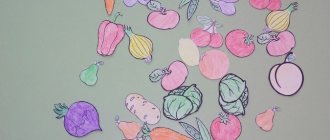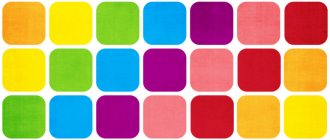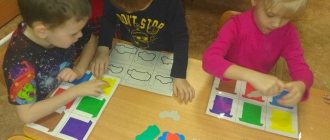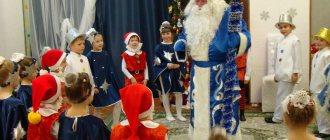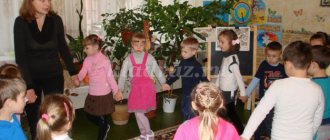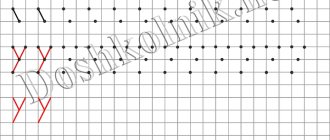Objectives of the game and preparation of didactic material
The locomotive for the game is a flat image made of cardboard, each car of which is painted in a certain color from the main palette. Transparent cells are attached to the carriages, into which game material is inserted. Various thematic images are used as material: numbers, geometric shapes, pictures of animals and plants, objects, transport and other things.
During the game, the train can be placed on a horizontal surface. Or you can hang it on a magnetic board - this is a more convenient and ergonomic option, allowing you to start playing at any time. If the train is attached to the board, the pictures should also have magnetic attachments. The number of trailers can be any, depending on what games the teacher plans to play with the students. The minimum quantity is 3 cars. But it’s better to do more, and then use all the trailers or only part of them for games.
The goals of the game are the diversified development of preschool children, including those with mental and speech disabilities.
The objectives of games with a train:
- expanding ideas about the world around us;
- strengthening cognitive interest;
- improvement of speech and thinking abilities;
- developing the skill of classification and ordering of objects;
- expanding mathematical knowledge, gaining the skill of counting, determining quantities;
- consolidation of ideas about geometric shapes and primary colors;
- development of fine motor skills, memory, perseverance, concentration.
For children of different age groups, you can come up with all kinds of games with a train.
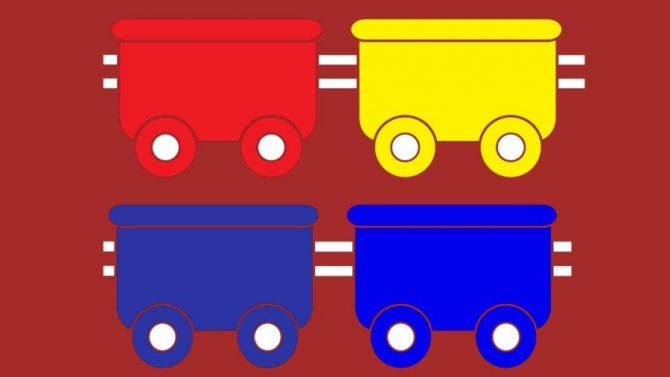
Travel game “Fun Train”
Completed by: Korniyaka N.V., teacher at MBDOU No. 23 in Nakhabino, Moscow region.
ABSTRACT
GCD for FEMP in the middle group “Fun Train” (travel game)
Program content.
Teach children to count to five; consolidate skills in comparing objects by length, width, height; develop ideas about geometric shapes; improve the ability to determine the position of objects relative to each other.
Material.
Geometric shapes (circle, square, triangle, rectangle) of different colors to indicate carriages; ticket cards with geometric shapes corresponding to the shapes on the cars; vegetables (cabbage, carrots, cucumber, tomato), fruits (apple, pear, orange, lemon); two baskets; stream and river made of paper; sticks for a bridge across the width of the river; for the clearing: high and low fir trees, stumps, mushrooms, hedgehog, bunny, bird; stripes with geometric shapes, paper butterflies of different colors on a string (for each child), four hoops.
GCD move
Educator.
Hello children! Do you want to travel by train? (Yes.) Then purchase tickets at the box office and take your seats in the carriages. The train will take us to a forest clearing. (Children use tickets with images of geometric figures to find their carriage - four chairs put together with the corresponding geometric figure. The teacher checks the tickets.) Our friend, Shaggy Dog, will be the driver today. Is everyone settled in their cars? You can go. (Gives the signal: “Too-oo-oo-oo!”. Children imitate how a train is traveling, knock their feet on the floor, read a poem.)
The locomotive is going, going,
Two pipes and a hundred wheels.
Two pipes and a hundred wheels,
The driver is a red dog.
Stop "Shop".
In the clearing we will meet many forest animals.
Let's buy vegetables and fruits for them, which we will put in two baskets. Let's count how many fruits are in the first basket, and now find out how many vegetables are in the second. (Children complete the task.)
Let's move on.
(The song “We’re going, we’re going, we’re going...” plays.)
“Train repair.”
Children, there was a problem with the train, we need to find it and fix it. (Hands out strips with rows of geometric shapes in which a given pattern is broken. Children explain where the error is and “fix the breakdown.”)
"The road to the forest clearing."
To get to the forest clearing, you need to cross a stream and a river. The stream is narrow, so you can cross it... (Children step and jump over the stream.) We quickly went down to the river, bent down and washed ourselves. What river? (Long, wide.) How can we get to the other side? (Build a bridge.) That's right! (Children choose from short and long sticks those that correspond to the width of the river, build a bridge across the river and cross to the other bank.)
Train and carriages
The game, which reinforces counting skills, is intended for preschoolers aged 4–6 years.
The teacher places images of numbers from 1 to 10 in the carriage cells, then asks the children to attach the carriages to each other in the correct order.
Didactic math game for preschoolers 3-6 years old
Didactic game for preschoolers “Mathematical Engine”
Author: Natalya Evgenievna Khokhlova Position: teacher-defectologist, MKDOU No. 18 (branch), Miass, Chelyabinsk region Name of resource: didactic game “Mathematical Engine” Brief description of the resource: game for preschool children on formation of elementary mathematical concepts, development of logical thinking. The purpose and objectives of the resource: strengthening counting skills, number composition, number series, ordinal counting; development of visual perception, logical thinking. Relevance and significance of the resource: the game can be used by speech therapists, defectologists, and parents in correctional work with children. Equipment: the game is made using a PC (personal computer), consists of planar images: a steam locomotive, trailers, wheels for trailers. Practical application: individual lessons, frontal correction lessons (as a demonstration of a task or a direct game “one at a time”). Method of working with the resource: 1. Individually: the child takes one of the trains.
A number is depicted on the wheel of the locomotive, the child places a trailer next to it and matches the wheels with numbers or dots to the trailer so that in pairs they make up the indicated number. 2. Front: used to demonstrate a task using a magnetic board and magnets; Children in their seats work orally and frontally. This game is aimed at strengthening counting skills and number composition. Option I
Place a train with several carriages in front of the child (the number of carriages depends on the child’s mastery of counting limits) and offer to number the carriages in order. For numbering, you can use any cards with numbers or use wheels from trailers.
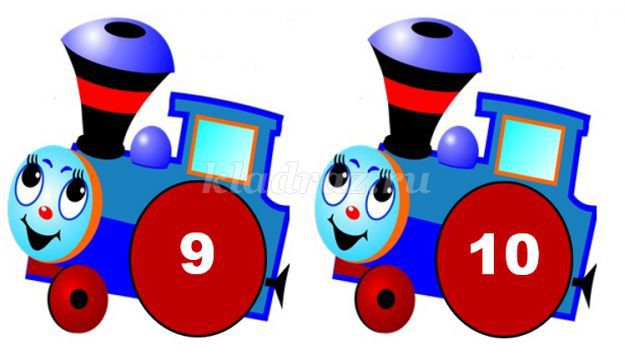
For example, a train within 3
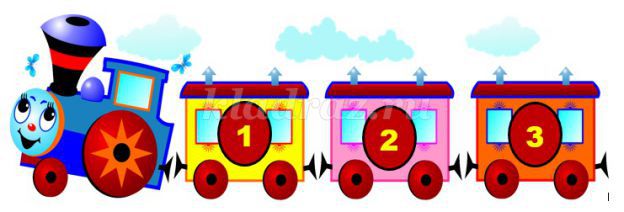
Then invite the child to count the total number of trailers, or count them in order, thus strengthening the ordinal count. Or, as an option to reinforce ordinal counting, invite your child to line up the trains with the numbers depicted on them in order.
Option II
Offer your child one of the trains with a certain number. Ask to prepare it for a long trip. But for this he needs to attach trailers. We don't know how many there will be. Therefore, we begin to attach one trailer at a time and select wheels for the trailer so that a pair of wheels together makes up the number depicted on the train. Carriages:
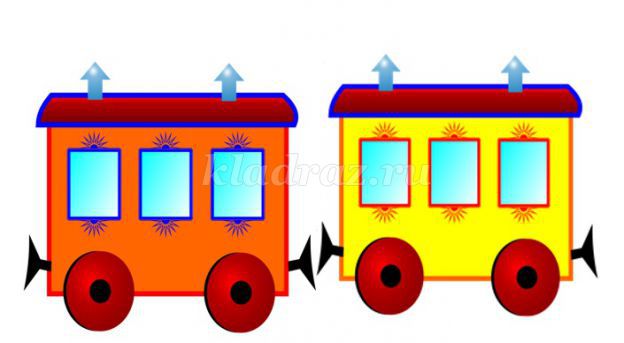
Wheels:
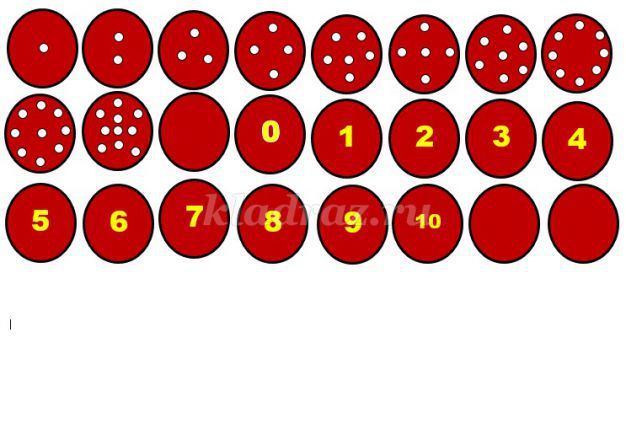
You can use wheels with dots or numbers. For example, the following trains can turn out:
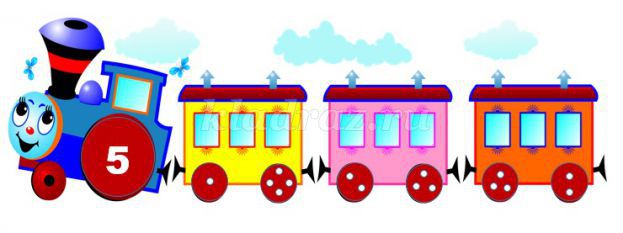
You can invite your child to count how many trailers the locomotive will carry. Come up with other tasks using this material. I wish you creative success!
We recommend watching:
Passport for the senior group math corner Mathematical game in kindergarten for preschoolers with learning difficulties Do-it-yourself didactic game for preschoolers 4-6 years old according to FEMP Mathematical games for preschoolers 3-5 years old in kindergarten
Similar articles:
Math tasks in pictures for children 6-7 years old
Exercises with counting sticks for preschoolers
Teaching mathematics using the Nikitin method
Math problems jokes for preschoolers
Mathematical riddles for preschoolers in verse with answers
Didactic game "Merry little engine"
This game for preschoolers aged 5–6 years also improves counting skills and develops thinking abilities and spatial orientation.
The teacher asks the children to connect the cars, insert cards with numbers into the cells in the correct order. Students, having completed the task, list the numbers, first in direct order, then in reverse. Next, the teacher calls a number, the children find the corresponding trailer, name the adjacent numbers on the right and left sides.
Didactic game for speech development in the preparatory group “Fun Train”
Goal: Improve the skill of the syllabic structure of words.
Tasks:
- Find words with a certain number of syllables on your own.
- Practice the relationship between the number of syllables and numbers.
- Development of memory, attention, thinking.
- Develop a positive attitude towards learning activities.
Nowadays, children are mainly interested in gadgets. Therefore, we educators have to structure the pedagogical process so that children are interested not only in class, but also after so that they want to return to this topic again and again. In the preparatory group, children begin to determine the number of syllables in a word.
I made a multimedia game in which children themselves go from the first to the last carriage, with the condition that they succeeded. For this purpose there is a train that carries car after car.
Slide 3
On the slide: car 1 and the words rooster, shirt, cancer. You need to correctly click on the desired word and then the next car appears. If suddenly a child presses on a cock or a shirt, a creaking sound is heard. If the word cancer is clicked, victory music plays, indicating the correct answer. (on the carriage there is a number 1, the word cancer has one syllable).
Slide 4
The child moves to the next slide, on which there is a train and a carriage with the number 2 and the words firecracker, goat, beetle. The correct answer corresponds to 2 syllables - this is a goat.
Slide 5
On the next slide, our train brought out a trailer with the number 3, the words provided: dragonfly, saw, poppy. Click on the word dragonfly and hear victory music.
Slide 6
The next slide brought a trailer with the number 4 and the words: baby goat, onion, starling. The correct word is little goat.
Slide 7
Next, the locomotive brought a carriage with the number 2 and the words: frog, watering can, wardrobe. The correct word is watering can.
Slide 8
The next slide greeted us with a train and a carriage with the number 1 and the words: duck, carriage, cat. The correct word is cat.
Slide 9
We go to the next slide and there a train and a carriage with the number 4 and the words: cuckoo, T-shirt, juice are waiting for us. The correct answer is cuckoo.
Slide 10
The next slide with car 3 and the words: mole, wolf cubs, varnish. The correct answer is wolf cubs.
Slide 11
Then a carriage with the number 2 and the words: birch, spruce, words. The correct answer is the word.
Slide 12
And the final carriage with the number 3 and the words: plane, cheese, fruit. The correct answer is airplane. And on the last slide we hear fanfare and read Well done!
The kids really enjoy playing these games. This game can be played by one child or several (whoever is faster).
Animal world
Need a set of images of birds and animals. You can play with these pictures in different ways:
- Distribute the pictures among the carriages in accordance with the categories “Wild Animals”, “Domestic Animals”, “Wild Birds”, “Domestic Birds”.
- Distribute the animals among the carriages. Name the passengers who travel to the Lesnaya and Selsky Dvor stations.
- Place the animals in the carriages and count their number. Name who travels in the first carriage, in the second and subsequent ones. Who sits in a certain carriage, who travels on the right and on the left side of it.
Musical and didactic game "Locomotive"
The game develops a sense of rhythm and an ear for music. It should be held in the music room. You need to prepare images of different musical instruments and insert them into the cells of the trailers.
Children take turns approaching the train, pulling out a picture from the box, and naming the instrument shown. Next, the child approaches the table with musical instruments laid out, takes the one that matches the picture, and tries to play it. It is important that the tools used are appropriate to the age-related abilities of preschoolers. These can be musical spoons, a triangle, a drum, a bell.
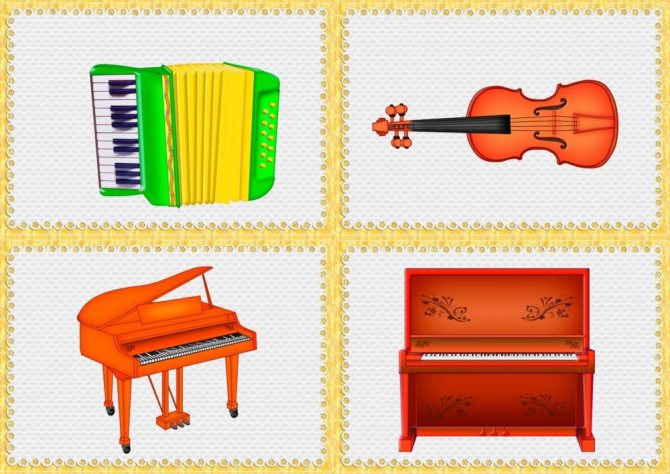
Didactic railway games for primary preschool age
Kindergarten is the first important stage in the training of future railway workers. The teaching staff carries out systematic work to familiarize children with railway transport and the professions of railway workers. The possibility of early career guidance is determined by the following factors:
• Preschool age of children is the most favorable period for the development of curiosity . This allows children to develop an active interest in railway professions.
• Parents of pupils work at the enterprises of JSC Russian Railways, and for children of this age it is natural to be interested in the work of their parents and to want to become like their fathers and mothers.
The implementation of this project is impossible without creating conditions for the education of future railway workers in kindergarten.
To do this, in younger groups, teachers use game aids - light geometric modules, covered in leather, which are easily rearranged in the process of transforming space, and didactic games made according to their own design.
We also involve parents in making games. These include picturesque rugs with removable image elements that can be transformed using buttons, Velcro or loops with buttons, and games made from waste material (many experts have noticed that children like everything new, non-standard, unusual).
We believe that such games allow children not only to transform the environment, but also contribute to their development in general.
Goal: development of speech and fine motor skills.
Progress of the game: small objects (various figures from Kinder Surprise) are laid out on the table at a distance of 5-7 cm from each other. When moving a chip (train), you need to go around all the obstacles without hitting it, naming the object.
Goal: develop visual memory. Fix the basic geometric shapes.
Progress of the game: the child is offered a picture covered on top with a white sheet with one hole. If the child cannot guess the picture, he is offered the same picture, covered with a sheet with two holes. And so on until the child names what is shown in the picture.
Goal: To consolidate the primary colors, to consolidate the concepts of “left” and “right”.
Progress of the game: the child is asked to match the train to the card of the corresponding color. As the game progresses, you need to draw the child’s attention to which direction the locomotive is traveling (left, right).
Goal: develop visual memory.
Progress of the game: The child chooses a picture he likes and begins to put together puzzles.
Note: puzzles consist of 3-12 pieces. It is not recommended to use cartoonish illustrations with distorted proportions.
Purpose: to consolidate the primary colors; be able to distinguish and name quantities (large, medium, small). Develop fine motor skills.
How to play: Place caps from plastic bottles of different colors and sizes in front of the child. Then they offer to “match” the wheels to the locomotive in size and color, placing plugs on the holes of the corresponding color.
"Caterpillar"
Goal: development of fine motor skills, color perception. Also used as a massage track (filler – peas, wooden sticks).
Progress of the game: children are asked to braid their hair and tie bows. Eyes and lips with buttons.
Progress of the game: children are asked to walk through a clearing, collect mushrooms and flowers. You can replant the Christmas trees (all the details are on buttons).
Progress of the game: children are asked to uncouple the carriages, open the bridge, board passengers or assemble a steam locomotive (locomotive parts with Velcro).
Progress of the game: children are asked to screw the lids around the edges in a certain alternation of colors.
How to play: Multi-colored laces are sewn along the edge, which you can learn to tie into a bow or intertwine.
Progress of the game: the child is asked to combine buttons of the same color with an elastic band.
Progress of the game: you can propose to build a bridge across the river (in the picture on the left), open the houses by unlacing them, and see who lives there (in the picture on the right).
Author: physical education instructor
Sukhinina Tatyana Viktorovna
Non-state preschool educational institution
"Kindergarten No. 161" JSC "Russian Railways"
The article is published in the author's edition
Vote also on the forum: HERE
What shape?
The game teaches the skill of relating objects to geometric shapes. The teacher lays out pictures depicting various household objects and asks the students to look at them carefully. Objects shaped like a circle should be placed in the cell of the first car, square-shaped objects should be placed in the second car, triangle-shaped objects should be placed in the third car, and rectangular objects should be placed in the cell of the fourth car.
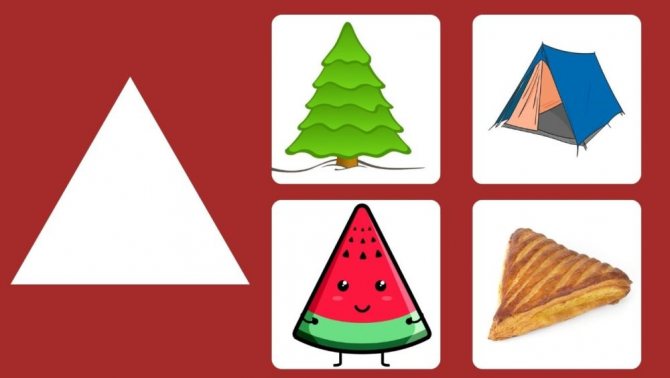
Sort by color
The game is intended for preschoolers 3–4 years old. The teacher shows an image of an object painted in a certain predominant color. The player’s task is to place the picture in a cell of a carriage painted in the same color.
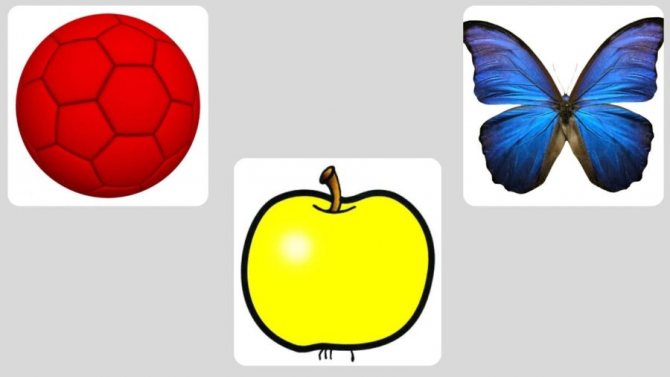
Brother sounds
For a game that teaches sound differentiation, only two cars are needed. The game task is to find among the laid out images objects whose pronunciation produces sibling sounds: hard and soft. These pictures need to be distributed among neighboring trailers. For example, the phonemes [p] and [p']: the child puts the picture “fish” in the first carriage, and “chicken” in the second.
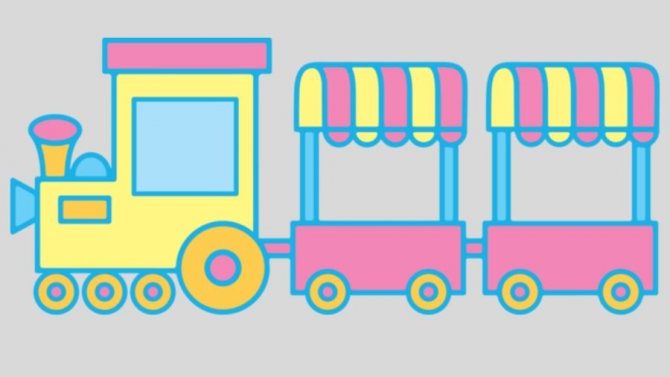
Where is the sound in the word?
The game uses 3 carriages. In the first you need to put pictures that depict objects with a given sound in the first syllable, in the second - objects with a sound in the second syllable, in the third - with a sound in the last syllable. The player selects a picture, clearly names the depicted object, and determines the location of the picture. For example, the sound “s”: the player puts a “dog” in the first carriage, “dishes” in the second, and “wheel” in the third.
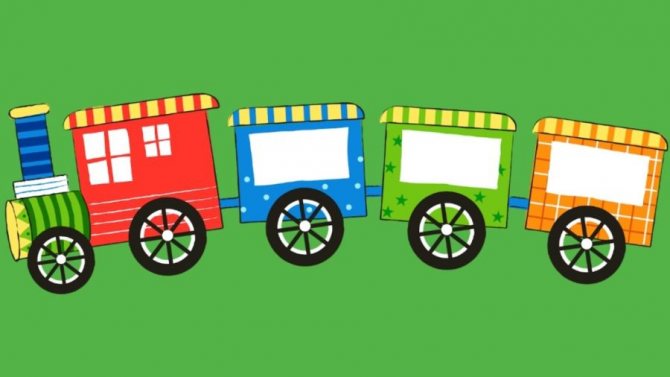
Didactic manual “The Cheerful Engine”
Didactic manual
"Merry little engine"
This manual is intended for children 4-6 years old. It can be used for individual lessons with a child, as part of a lesson, in children’s independent activities. Parents can also make it and use it to prepare their child for school.
The game manual consists of multi-colored trailers and several sets of cards (cards with pictures, numbers, letters, examples, geometric shapes).
Goals of the game guide:
1. Development of speech and communication skills.
2. Development of mathematical concepts.
3. Development of independent play activities of children.
4. Development of attention, memory, thinking, creative abilities.
Examples of games using the manual:
Game "Let's make a train."
Option 1.
Target:
consolidate children's knowledge of number sequences.
Progress of the game:
in front of the child there are trailers in a chaotic order.
The teacher says: “For our train to set off, we need to arrange the trailers in order from 1 to 10.” The child is making a train. The trailers can be arranged either in ascending order from 1 to 10 or in descending order.
Option 2.
Target:
development of arithmetic skills and abilities.
Progress of the game:
The child is asked to perform an arithmetic operation to determine the number of the carriage on the train.
Game "Find the missed carriage."
Target:
practice finding the missing number.
Progress of the game
: in front of the child there is a train that is missing some car numbers. The child must arrange the missing cards with numbers.
Game “Load the trailers”.
Option 1.
Target
: consolidate knowledge of letters, the ability to determine the first sound in picture words. Develop phonemic hearing and perception.
Progress of the game
: Can be played by one or more children. Cards with letters are placed in the locomotive. Children must fill the trailers by arranging the pictures correctly. Only those items whose names begin with a given letter will travel on the train.
K - picture, cat, pan, paints.
Option 2
Target
: consolidate the ability to determine the number of syllables in words.
Progress of the game
: children must load the carriages by matching pictures so that the train carries goods whose names consist of 1, 2, or 3 syllables.
Option 3
Target:
teach children to compare the shape of the depicted object with a geometric figure.
Progress of the game
: pictures with geometric shapes are placed in the locomotives; in front of the child there are pictures that he must arrange in the carriages, focusing on the shape of the object.
Game “Who is faster? "
Target:
practice differentiating sounds (S-SH).
Progress of the game:
Two children are playing. Cards with the letters S and Ш are placed in two locomotives; cards with object pictures, the names of which contain these sounds, are laid out in front of the children. One child must load things with the sound S in their names, the other - things with the sound Sh. The one who has the most cars on the train wins.
